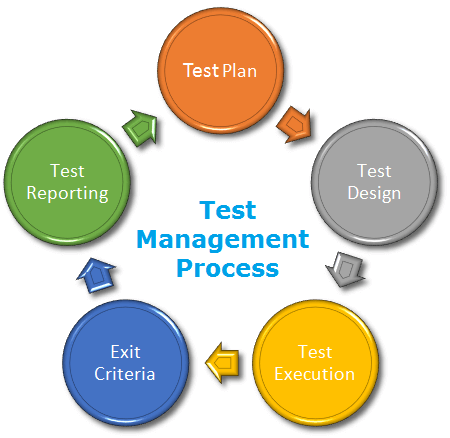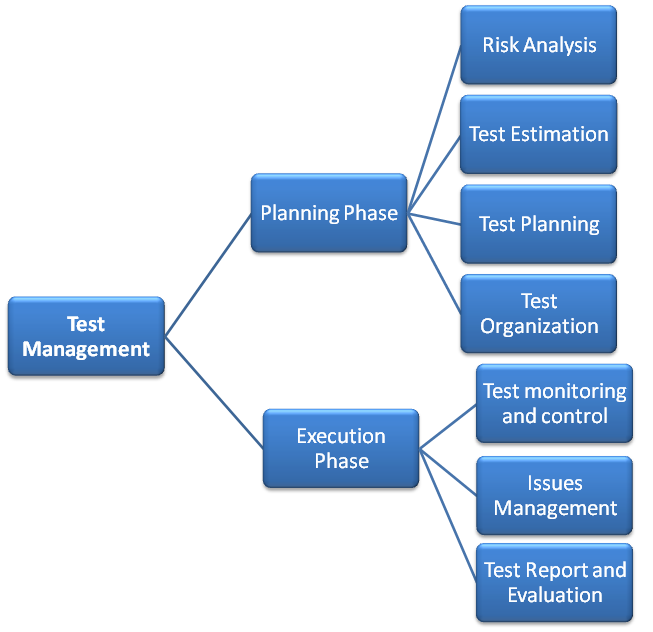
Test Management Process: A Complete Guide
June 21st, 2019

Test Management is very important to ensure high-quality software delivery and to ensure all-inclusive and high-end testing, a proper test management system is required. It ensures that the testing process proceeds in a correct manner.
Let us have a deep insight on Test Management.
What is Test Management?
Test management as its name signifies is the process of managing the testing process. There are various tools that are deployed for Test management. They help in the management of both automated and manual tests that are already specified by a test process.
To sum this up; Test Management is a method of
- Organizing and controlling the Testing process.
- Warranting traceability, visibility, and control of the testing process to deliver high-quality software

Why do We Need Test Management?
Test management ensures the delivery of high-quality products that completely suffice on customers’ requirements.
It assists in the delivery of software within tighter deadlines, allowing collaboration among developers and testers.
In short leveraging test management process efficiently enhances:
- Customer satisfaction
- Smoother and more consistent projects
- Timely product delivery
Let us move ahead and read more about it.
Who is Responsible for Test Management?
Though complete testing team along with the developers play a vital role in the process; the test Manager/lead is in charge. He acts as test support and is involved in resource planning & management, and resolving issues that create a hindrance in the testing effort.
The Test Lead / Manager are responsible for:
- Leading the Test Team.
- Outlining testing scope.
- Dedicating and managing test resources.
- Applying test metrics.
- Scheduling, installing and handling the testing effort.
- Thorough understanding of his role within the organization.
Test Management Process
Test Management is very important to enhance software development and delivery process. But the benefits of can only be availed if the complete process is carried out in a proper and systematic manner.

The complete test management process can be divided into two parts:
-
Planning
-
Execution
They are again divided further into sub-processes:
1. Planning
- Risk Analysis
- Test Estimation
- Test Planning
- Test Organization
2. Execution
- Test Monitoring and Control
- Issue Management
- Test Report and Evaluation
1. Planning
The first phase is planning, where all the planning for the complete test cycle takes place.
- Risk Analysis and Solution
Risks are the probable problems that might result in the SDLC.
It is the very first step in test management. The test manager starts working on it even before the beginning of the project. Software is susceptible to risk and early detection of risks help evade possible loss & save on project cost.
- Test Estimation
Test estimate calculates the time and the efforts that any task would require to complete. It is one of the most important tasks in Test Management.
Benefits of Correct Test estimation:
- Correct test estimations result in superior planning, execution, and monitoring of tasks.
- It also results in more precise test scheduling.
- It helps apprehend results in more assertively.
- Test Planning
Test planning is very important for carrying out all testing activities smoothly and efficiently. The test plan creation is the main aim of test planning. A test plan defines the approach, scope, resources, and calendar of proposed testing activities.
A Test Plan thoroughly defines:
- Test Strategy
- Test Objective
- Exit /Suspension Criteria
- Resource Planning
- Test Deliverables
- Test Organization
When all the planning is being done and everything is in its place it’s time to organize an efficient testing team. A skilled team is very important to execute testing effectively.
2. Execution
The second phase is test execution, where testing is actually executed to find testing results.
- Test Monitoring and Control
What if you find your test resources are falling short of and your schedule has just messed up? You will need to Monitor and Control Test activities to take back control of the project. Test Monitoring and Control keeps a check on test metrics to make sure that project is on time, within the budget and is proceeding well.

- Monitoring
During monitoring, the test team assembles, records, and reports relevant details on on-going project activities.
The test manager is accountable for the following activities in this phase:
- Outlining project goal
- Observing the project performance
- Comparing planned vs. actual performance
- Recording and reporting of identified defects
- Controlling
The main aim of this phase is to manage any up and downs in the testing process and to bring back the performance of the process as planned. It is done using the data received from test monitoring. In Test control, any deviations in the project are adjusted to as planned in the test plan.
- Issue Management
We have already discussed risk management, but if at times we fail in risk management and these risks convert into the issue, we have to make sure that these issues are efficiently dealt with so that the final build is bug–free.
Software projects are highly prone to unexpected problems. But these issues need to be efficiently dealt with. If they are not properly catered they can cause huge loses to your business. These issues could be related to tight deadlines, improper resources, etc. Ensure proper management of the issues in your project.
- Test Report & Evaluation
When you are all happy that your project is completed, it’s time to take out a little time to prepare and test report and evaluate the test data.
Test Management Responsibilities
There are a few tasks that are expected to perform, some of them are:
- The most important role and responsibility is to improve the quality of the software.
- It is also responsible for the creation and upkeep of product metrics.
- It empowers developers to ensure that less design or coding errors are inserted in the code.
Test Management Tools
Test management requires a lot of planning. The test manager needs to select an efficient team, assign them various responsibilities based on their capabilities and so on.
One of the major decisions to be taken by the test manager is to select the best test management tool for the complete process.
Functions of The Tools
- Automatic generation of the required test matrix (RTM) that indicates functional coverage of the product
- Testware management
- Test scheduling
- The logging of results
- Test tracking
- Incident management
- Test reporting.
Tools Selection Principles
You should not just randomly pick any test management tool. Choice of test management tool depends on your requirements and its functionalities.
Also Read: All Info About Software Development Engineer in Test(SDET)
Take time to analyze what you expect from this tool and then patiently study various features and pick the correct one for your project.
Here are the Main Questions that you should ask before finalizing the Test Management Tool for your Project:
- How capable is the test management tool to manage your projects and your team?
- Does this tool support develop test cases, test plans, test scenarios or user stories?
- Does this tool supports test runs, managing the testing process, usability, and efficiency?
- Is it capable of creating test reports?
- Is bug tracker available in this tool and what its speed is?
- Check out for some other features availability like import/export, incorporation with other systems, crash analytics, etc.
Test Management Tools
Some of the best test management tools are
- TestRail
- TestLink
- EasyQA
- PractiTest
- JIRA
- qTest
- TestCollab
- TestLodge
- QA coverage
- TestCaseLab
- Zephyr
What are the Challenges in Test Management?
- Insufficient time for testing
- Lack of testing resources
- Budget and schedule constraints
- Lack of testing documents.
- The complexity of the requirements to test and validate
Test Management Best Practices
- Make Sure you Start Testing Activities at the Earliest Possible:
Starting testing at the early stages of SDLC is very beneficial. But many of us even after being aware of it does not follow it. This leads to the detection of bugs at later stages resulting in the additional cost of rectifying them. This also delays the whole process as it will increase the time to rectify it and to retest it.
- Execute Iterative Tests:
Iterative testing approaches are highly beneficial and hugely recommended. Such approaches help in the creation of testing assets and help save a lot of time.
- Reuse Test Assets
Reusing test assets like test automation scripts, test procedures, test cases, etc. can save a lot of time and effort. So try and reuse test assets whenever possible. You can leverage these skills to foresee which assets can be reused or not.
- Try to Improve the Time Spent:
Always be on a trail to improve product quality and efficiency of the team. It can save you a lot of time and effort.
- Deploy Requirement Based Testing and Testing Strategies:
Different types of testing processes require different types of test approaches. It is always suggested to use a test approach based on your test requirements.
Such practices can help you get better testing results and promises you faster delivery of a quality product that enhances your customer experience. Such an approach also reduces test efforts and time to test.
- Ensure Coordination Among Co-Located Testing Resources:
Ensure that the co-located testing resources are effectively coordinated. This coordination helps control issues related to testing resources, enhance productivity, and mend timelines; thus resulting in better ROI.
- Utilize Malleable Testing Processes
Every project has different requirements and hence needs to be tested differently. A flexible test management process is the need of the day to create an automated workflow.
This process should be able to repeat itself and should also permit optimization and modification of prevailing workflow as per the need.
- Utilize DevOps:
With more competitive business, new testing processes are now ruling the industry. DevOps is an approach that focuses on the close collaboration of developers, testers and operation’s team.
This approach helps in maintaining uniformity in forthcoming releases, decreasing defects, speedy and iterative development of software, speeding up business growth, etc.

- Communication is the key to successful Test management
The proper test management also depends on proper communication of all appropriate data such as goals, status, etc. To the stakeholders in the apt format, and at the right time.
- Wise Automation can bring Huge Benefits
Accomplishing these tasks requires a lot of time and efforts. Using automated management tools can save you a lot of time and efforts while promising you for effective and efficient test results.
Conclusion
Test management is a very important process of software testing. It assures the better testing results and timely delivery of the final product. Make sure you follow the best test management practices and assure 100% customer satisfaction.


 Software Testing Events
Software Testing Events App Testing
App Testing Web App Testing
Web App Testing Game Testing
Game Testing Automation Testing
Automation Testing Load Testing
Load Testing Security Testing
Security Testing Performance Testing
Performance Testing Hire a Tester
Hire a Tester





